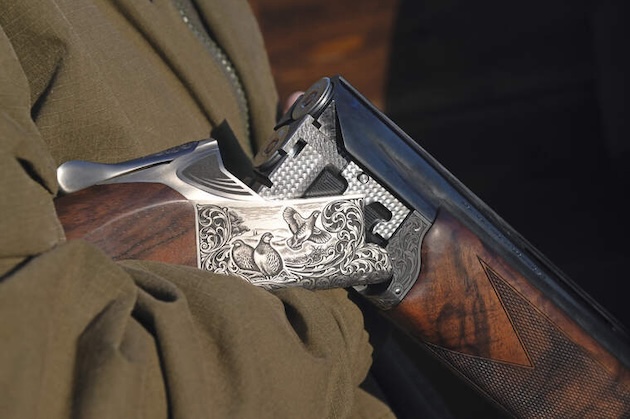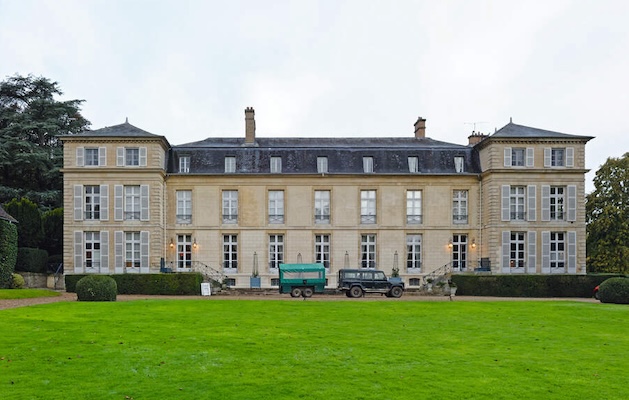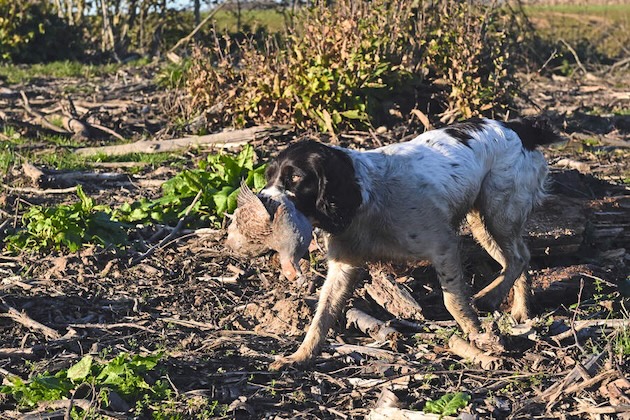A driven shoot in the heart of traditional grey partridge country was the perfect place to put Browning’s latest shotgun through its paces, writes Alexandra Henton
Sporting adventures are thrilling, and whisking overseas just adds to the lustre. My sporting trips tend to result in enough material to perform a comedy skit, from boar hunting on the estate of a nascent Bond villain to getting hooked in a tree when hunting in Ireland only to find, four fields later, the bottom of my breeches had remained stuck as my mount had bounded forwards. Salvation came in the shape of an old hunting pal with sufficient safety pins attached to the bottom of his stock to make suitable repairs on the hoof: an excellent wingman.
Browning’s recent invitation to pop across the Channel and test its new 825 shotgun (read the full review of the Browning 825 here) in the field proved to be three days of a significantly enhanced version of sporting life as we know it at a quintessential French chateau, set in charming grounds, that boasts a hunting area of 5,000 acres. Situated just over 30 minutes north-west of Charles de Gaulle airport, Sandricourt is easily accessed by car – a straight two-hour run down the Route d’Anglais from the Eurotunnel. Nip off at a péage, drive past a grey partridge beat and you have arrived. And yes, you did read that correctly, it was reared grey partridges that we were to pit our wits (and the new Browning shotguns) against the following day.
The Sandricourt estate is divided into three separate sporting entities: one for grey partridge, one for pheasant and the other for big game, namely wild boar and roe deer. Presiding over the sport is estate manager Thibaut Constant, who has been at Sandricourt for eight years, and headkeeper Steve Toft who is in his second season presenting exceptional birds at this most remarkable shoot.
Rearing grey partridge
Historically, Sandricourt was one of the premier wild grey partridge estates in France. “Large, plain areas,” as Toft, who has wild partridge running through his veins, explains. “There are others nearer the Somme and further south,” he adds but it is Sandricourt, under the direction of Constant, that has reintroduced the birds that French guns love to shoot. And it is catching on, with teams from the UK and US taking days to shoot grey partridges in rare style.

A reared grey
It is far from easy rearing these birds, let alone presenting them in the proper fashion, as Toft admits. “You have to think differently when managing them, as they aren’t redlegs. You can’t overshoot them, although you can move them about. But push them too much and they’ll find a way out,” he cautions. Unlike much Continental shooting, the grey partridges (and Kansas-cross pheasants) at Sandricourt are released just as we would do in the UK before the start of the season. “We use three small French game dealers. They are not big commercial concerns but boutique ones, rearing good birds. I’ll go to see them before they arrive, and once they are delivered in covey sizes, they are released within two to three days.” This is, of course, when all the hard work begins.
“It was old school,” says Toft of the mixed pheasant and grey partridge shoot in Dorset where he grew up. “I had an old retired keeper, a renowned grey partridge man, as my mentor and I would walk with him looking for scrapes, nests and watching the partridges pair up.” Just before his 16th birthday he was dropped off at the headkeeper’s house at Chilbridge Farm by his brother. “I lodged with him for five years as an underkeeper, and was schooled in the proper way of doing things,” he says. “We were in tweed 365 days of the year.” A move to Bisterne under headkeeper Frank Brewer was another education: “I learnt a lot from Frank, who was a third-generation keeper, very balanced.”
A headkeeper role in Cornwall, postings overseas (to Morocco, Italy and a year in Canada – where the potential shoot “was never going to work; there were too many moose and brown bears” ) and nine years as a headkeeper in the Scottish Borders followed before the call came for Sandricourt. The estate had traditionally had English keepers, although Toft’s predecessor was French, and when he arrived with his grey partridge background, he immediately set about tweaking the drives to get the best from the birds. “There are two roads that run through the estate, so we have to be mindful of the nature of the ground,” explains Toft. “I’d prefer coveys of 10 to 15 going over the guns but the bande de chasse (game covers) are long and tend to roll the birds on.”
Charged anticipation
Like grouse, grey partridges gather up quickly. As we waited in the butts on the first drive, Le Grande Piece, on an ethereally cold, mist-laced morning there was an atmosphere of charged anticipation from the line of guns, most of whom hadn’t seen, let alone shot, grey partridges in number before. There was the odd bark of laughter and a rumbling of conversation in the butts as we waited for the beating team to approach. “Shoot at them, in front, get stuck in. Leave any pheasants you may see,” Constant had instructed us during the briefing. “Once you hear the first horn, it is blue sky and behind.” True to their nature, the greys packed and swung away from the sun (and us) although Italian hotshot Simone Bertini added to the bag, as had Jonny Carter on the far end of the line. The excitement of shooting greys comes from their unpredictability, and the speed they require from guns. And so, as they returned the drive, with eye now in and the opportunity as birds came over, I added my first to the bag.

A gun fit ready for purpose
The return done, we were ready for a warming shot of bouillon and a sustaining morsel before climbing back into the converted fire truck to head to the next drive, La Chenevière. Birds this time were coming straight over a hedge in front of us. The peep of a whistle might have helped (a useful clarion call) as smaller coveys and singles weaved their way through the butts. However, they were addressed well by the line and it was with smiling faces, slightly cold feet and our pidgin French warming up that we headed back to the house for lunch.
As with so many things in France, lunch was elegant and sumptuous: four courses, cheese before pudding, a glass or two of excellent wine and all served on small plates (surely the key to the French managing to eat so well yet remain lithe). Foie gras, wild boar, scallops, cheese – a soupçon of each did us handsomely. Buoyantly we made our way back on to the gun bus and out to the last three drives of the day.

Superlative French food for lunch
With guns now in the swing of things, we shot the CD105 area (named for the road that comes through the estate) and then headed to the last of the day: La Charbonnière. As the beating line brought the birds towards the butts, the coveys packed up and moved from one strip of the bande de chasse to the other, finally flying over the guns in rare style. But it was the return, where the covey broke over the brow of the hill, giving me a right-and-left behind, that left us in awe. Charlie Jacoby was shooting elegantly to my left, his 100-yearold breeks, jacket and trilby straight from a Norfolk oil painting. What a privilege to see grey partridges fly as they did.
Back at the chateau the ramasseuses (picking-up team) created le tableau – the bag displayed, the scene lit by burning torches either side – for us to show our respect as Toft read out the day’s bag and thanked his team: Fin, Ludo, Patrick and his apprentices Jules and Baptiste, as well as his wife Julie. “The ramasseuses are my old guard,” he says. “Some of them were born on the estate; they are now friends. Julie [Toft’s wife] is part of the team, and they are a lovely bunch of people, as are the beaters – the whole team. I’m very much a team-spirited headkeeper.”
The season for grey partridges finishes at the end of January (the French pheasant season runs until the end of February) and Toft is hopeful there will be “80 or so pairs left after the season is done. I want to encourage them to nest, to increase the wildness and put some balance into the birds we have,” he says. “We’re making slight changes to the cropping regime for next season so we are putting down what is best for the greys. We have nesting cover on south-facing areas of the beat to help them. And they will nest in an open field if there is enough food and water. We feed and water as much as we can but that does bring in the boar, which is a big problem.” Night shooting is not allowed in France, so predator control is tough, and the boar are particularly hazardous for grey partridges. “Our job is continuous boar management,” says Toft. “But it is worth it, as we have a true English-style driven shoot.”

A pheasant is addressed in high style
High spirits
That holds fair for the pheasants we addressed the following day. I had missed out on a loader the previous day (although Browning’s Adrien Koutny did sterling stand-in work) but as we walked down to the first drive, Le Goulet, I was accompanied by Anthony: silent, hirsute and effective. The middle of the valley was once covered in maize but under Constant and Toft the cover crop had been removed, pushed over the ridge, grass laid down and birds shown over the guns standing feet below in a scene that was pure English. As we passed the telltale muddy debris of boar on the forage, spirits were high. Glorious sunshine, delightfully crisp weather and a smattering of French in the air – enough to make one feel vivant.

Walking to the first pheasant drive
Bang, bang! I turned to see Anthony looking rather desolate as he popped another couple of cartridges into the Browning 825 Prestige I had failed to wield efficiently enough on the first birds over. Spurred by his nascent disappointment, I smartly dropped the next two. “Double” came the perky reply over my shoulder, followed by another two “doubles”. We were on good terms now, and as pheasants streamed from the bank in front of us the whole line put the new shotguns to good use. At Le Peintre birds flew from towering woodland in front over guns who stood with an artist’s cottage picturesquely nestled behind the line. The third drive, La Côte Picard, came after lunch and required sunglasses and steely focus as the birds flew at serious height over the double line of guns below. “It’s a perfect last drive,” Toft says of L’Hectare, a woodland glade where birds set fast and determined in a final hurrah as the temperature dropped and the day came to a wonderful close. There are nine pheasant drives on the estate, as well as eight partridge drives (which can be returned), so enough sport to keep even the keenest teams of guns interested.
As we gathered for a pre-dinner drink in the salon, chatter came to rest on the reason for such a jolly and cosmopolitan gathering. Accustomed to a gun that can sometimes kick like a mule, my shoulder was remarkably unscathed by two days’ brisk shooting (heads up to the Browning recoil system) and the balance of the gun between my hands had certainly assisted a sometimes faltering swing, much to Anthony’s delight as we were handed back our cards complete with individual cartridge-to-kill ratios (an unnerving detail subscribed to on the Continent) at the end of the day. The team of Spanish, German, Belgian, French, Italian and English guns had put the 825 soundly through its paces and not found it wanting. All at an exceptional English driven shoot in the heart of French partridge country. Domaine de Sandricourt is a sporting adventure with true French flair.






